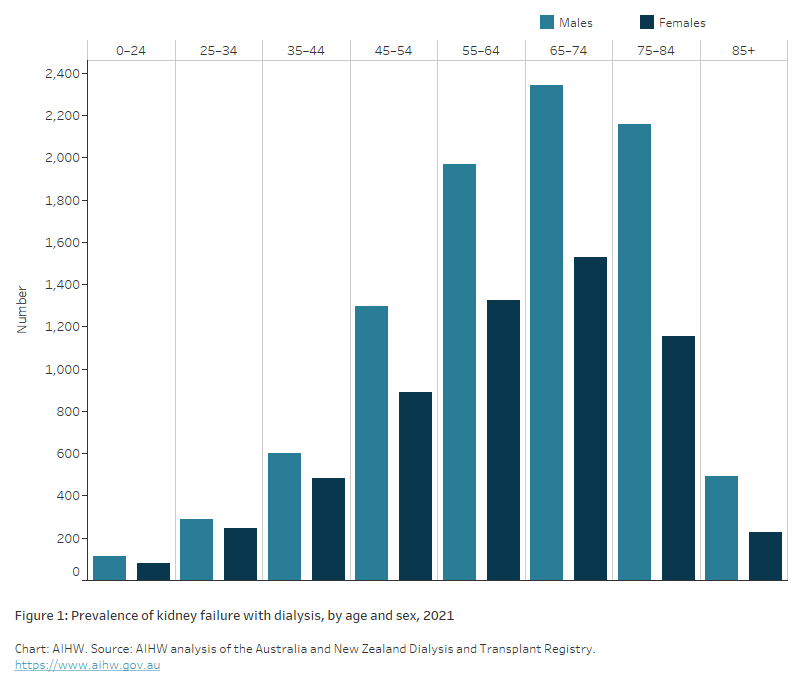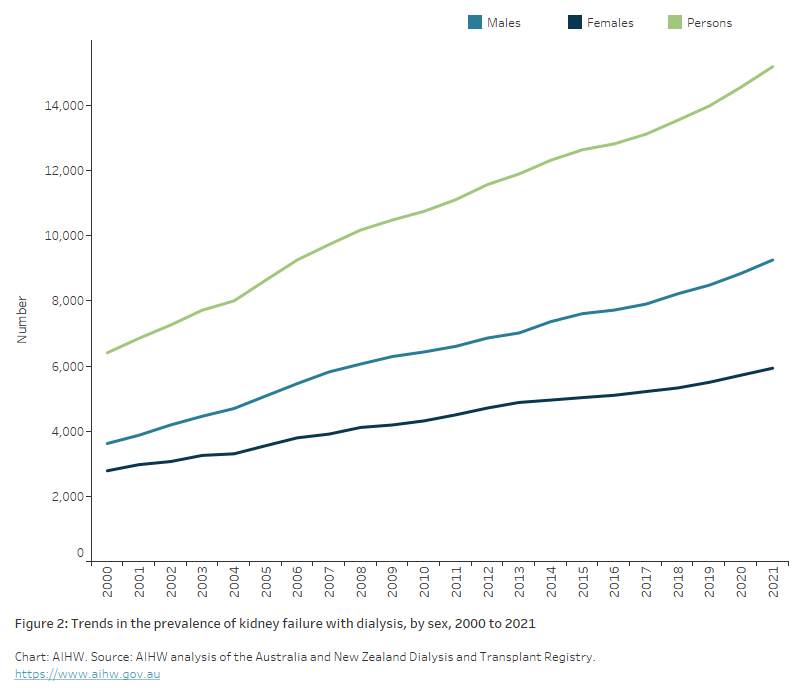Dialysis
Page highlights:
In 2021, 15,200 people with kidney failure received dialysis.
The number of people with kidney failure who received dialysis more than doubled between 2000 and 2021, from 6,400 to 15,200.
In 2021, 82% of people with kidney failure who were receiving dialysis underwent haemodialysis, compared with 18% who used peritoneal dialysis.
Dialysis is an artificial way to remove waste and excess water from the blood, and regulate safe levels of circulating agents (such as potassium, calcium and phosphorous) in the body, a function usually performed by the kidneys. It is most often provided to treat chronic kidney failure, but is sometimes needed in cases of acute kidney failure, where the kidneys have been temporarily damaged due to illness or injury.
For more information, see What is dialysis?
Variation by age and sex
In 2021, 15,200 people with kidney failure received dialysis (9,300 males and 5,900 females).
The number of males who received dialysis was higher than the number of females in all age groups. The number was highest in the 65–74 year age group (2,300 men and 1,500 women). The number of people with kidney failure receiving dialysis reduced sharply in people aged 85 and over (Figure 1).
Figure 1: Prevalence of kidney failure with dialysis, by age and sex, 2021
The bar chart shows the number of people living with kidney failure who are being treated with dialysis in 2021, by age group and sex. More males than females were treated with dialysis across all age groups. The number of people receiving dialysis for kidney failure increased with age until peaking in the 65 to 74 year age group for males and females.

Trends over time
The number of people with kidney failure who received dialysis more than doubled between 2000 and 2021, from 6,400 to 15,200.
The number of males receiving dialysis in 2021 was 2.6 times as high as in 2000 (9,300 and 3,600), while the number of females receiving dialysis was 2.1 times as high (5,900 and 2,800) (Figure 2).
Figure 2: Trends in the prevalence of kidney failure with dialysis, by sex, 2000 to 2021
The line chart shows the number of people receiving dialysis, by sex, from 2000 to 2021. Overall, there has been an increase of 137% in the number of people receiving dialysis, from 6,400 to 15,200. The increase was larger for males (156%) than females (113%).

Dialysis type
Haemodialysis is the most common type of dialysis received by people with kidney failure.
In 2021, 82% of people with kidney failure who were receiving dialysis underwent haemodialysis, compared with 18% who used peritoneal dialysis. In 2000, the corresponding proportions were 73% using haemodialysis and 27% peritoneal dialysis (Figure 3).
Figure 3 and 3(b): Trends in prevalence of kidney failure with dialysis, by type, 2000 to 2021
The line chart shows the change in the type of dialysis people receive, from 2000 to 2021. The overall number of people receiving haemodialysis has increased from 4,700 people in 2000 to 12,500 in 2021. In contrast, around 1,700 people received peritoneal dialysis in 2000 compared to 2,700 in 2021.

Haemodialysis treatment location
In 2021, 65% of people with kidney failure receiving haemodialysis were treated in satellite facilities, with 25% treated in hospital and 9% at home. A satellite facility has been the most common location to receive haemodialysis since 2000 (Figure 4).
This reflects changes in the kidney care landscape, with the expansion of satellite kidney care centres, to better meet the needs of the population with kidney failure.
The number of people with kidney failure receiving haemodialysis has risen across all dialysis locations. From 2000 to 2021, numbers increased:
- by 271% for satellite haemodialysis care, from 2,200 to 8,200
- by 85% for hospital haemodialysis, from 1,700 to 3,200
- by 51% for home haemodialysis, from 741 to 1,120.
Figure 4: Trends in prevalence of kidney failure with haemodialysis, by location, 2000 to 2021
The line chart shows the change in the number of people receiving dialysis at satellite, home, hospital and community locations, from 2000 to 2021. This number has increased across all locations, however the number of people receiving haemodialysis in satellite facilities has increased the most, from 2,200 in 2000 to 8,200 in 2021, with 65% of people receiving haemodialysis at satellite facilities in 2021.

Kidney care units in Australia
Kidney transplants and dialysis are usually performed in specialised kidney units in hospitals, satellite facilities and transplant centres. Australia has more than 100 kidney care ‘parent’ units that are typically based in hospitals, and over 300 locations for dialysis treatment (ANZDATA 2022). It is common for parent units to be associated with one or more satellite units that provide access to dialysis and transplantation services, and to inpatient hospital care.
In 2019, an ANZDATA survey found that the size of kidney units varied considerably across Australia, with over half treating fewer than 250 patients, and the largest caring for well over 1,000 patients. Kidney transplantation was available in 40% of the units.
On average, each unit had 3 full-time consultant nephrology staff. Most units also had physician trainees, along with nurse practitioners, nurses, dietitians, social workers, pharmacists and transplant coordinators (McDonald et al. 2021).
References
ANZDATA (Australia and New Zealand Dialysis and Transplant Registry) (2022) ANZDATA 45th Annual Report 2022, ANZDATA, Adelaide, accessed 16 March 2023.
McDonald S, Hewawasam E, Hurst K, Irish G and Clayton P (2021) ANZDATA special reports 1: unit survey 2020, ANZDATA, Adelaide, accessed 8 April 2022.


